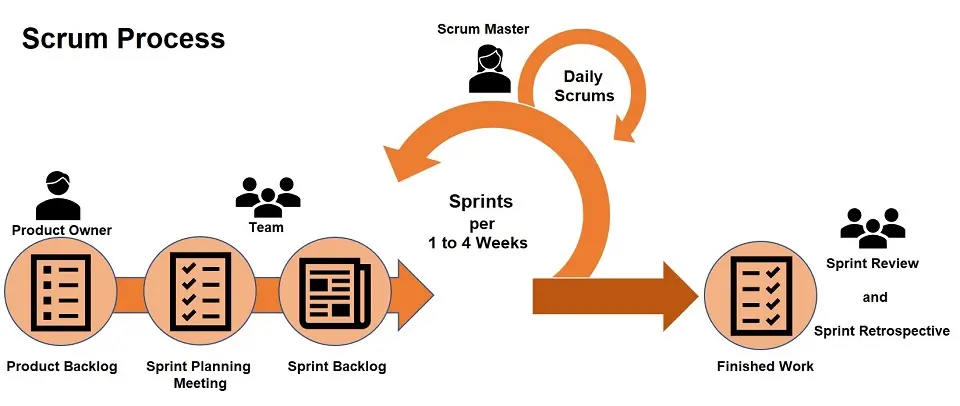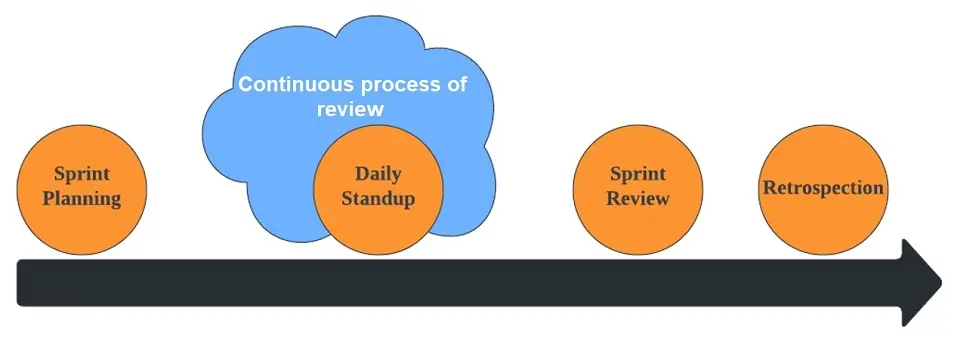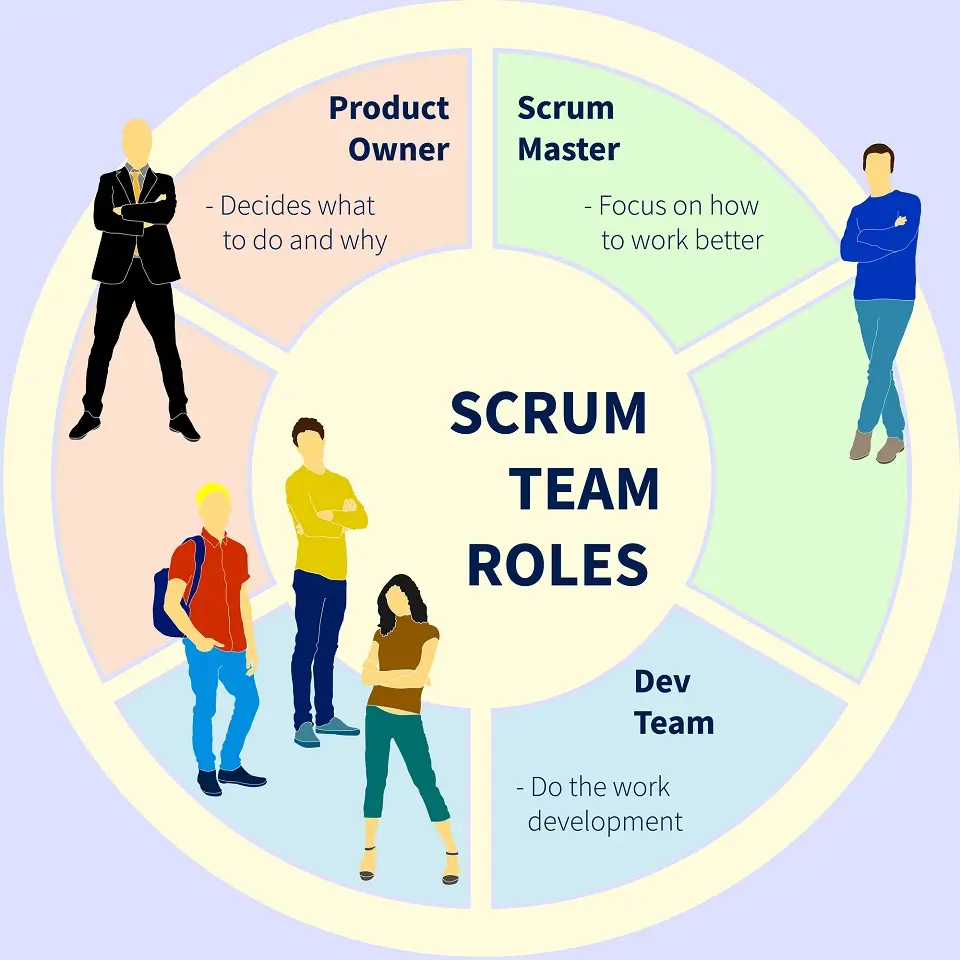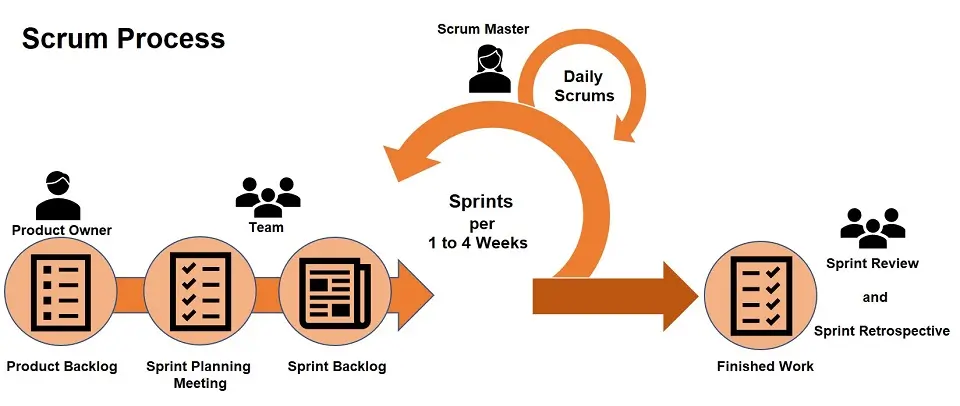Scrum Methodology for Agile Project Management

The Scrum methodology for project management was first introduced in 1995. The concept of Scrum was presented by Jeff Sutherland and Ken Schwaber in a paper titled “The Scrum Development Process” at the OOPSLA conference (Object-Oriented Programming, Systems, Languages & Applications) in Austin, Texas.
However, the methodology has been in development since the early 1990s. Sutherland and Schwaber drew upon previous work and ideas, notably those presented in the 1986 paper by Hirotaka Takeuchi and Ikujiro Nonaka, titled “The New New Product Development Game”.
The paper by Hirotaka Takeuchi and Ikujiro Nonaka described a holistic and flexible approach to product development, similar to what would become the foundation of Scrum.
What is Scrum?
Scrum is a framework used in Agile project management, particularly software development, to organize and manage work more effectively. It’s a form of agile methodology that emphasizes flexibility, collaboration, and adapting to changing requirements. Here are the key components of Scrum:
- Roles:
- Scrum Master
- Product Owner
- Development Team
- Artifacts:
- Product Backlog
- Sprint Backlog
- Increment:
- Events/Ceremonies:
- Sprint Planning
- Daily Scrum (or Standup)
- Sprint Review
- Sprint Retrospective
- Principles:
- Transparency
- Inspection
- Adaptation
Before going into the details of the above components of the Scrum Methodology, let’s first see what a Sprint is.
Sprint

A Sprint is a short timeframe in which a scrum team works to complete a task or set of tasks. Sprints can vary as fast as one week or as long as a month. They occur one after the other, with no breaks included.
Before a sprint begins, there is planning involved (sprint planning), which needs to go under review once the work is complete (sprint review). There is also an additional insight into how the team worked together (sprint retrospective).
During each sprint, the scrum team will collaborate to complete the list of increments, where each of these completed increments should be at a releasable standard. This means the increment can be delivered, as it has been thoroughly tested and approved.
Scrum: The Roles

Scrum has three roles: ScrumMaster, the Product Owner, and the Team. These team members work closely with one another to ensure the overall performance of the workflow is quick and easy.
1. ScrumMaster
ScrumMaster, also called “Scrum Master,” is the process’s keeper. They are responsible for ensuring that the process runs smoothly, dealing with any obstacles that may come their way, increasing overall productivity, and managing the overall process.
Their responsibilities include:
- Ensuring that the team follows the Scrum process
- Improving the productivity of the development team and the overall working environment through creativity and empowerment.
- Managing and keeping up-to-date information and tasks about the team’s progress with other team members.
- Meeting the Product Owner’s objectives through Scrum.
- Teaching the Product Owner how to maximize return on investment (ROI).
- Improving the engineering practice and tools.
Scrum Master Vs. Project Manager
People new to Scrum methodology often ask the difference between a Scrum Master and a Project Manager.
Here’s a detailed comparison:
Role Focus:
- Project Manager: A project manager is responsible for the overall success of a project. They handle the planning, execution, monitoring, control, and closure of the project. Their role often involves resource allocation, budget management, risk management, and stakeholder communication. Project managers typically have authority over team members and make key decisions.
- Scrum Master: A Scrum Master, on the other hand, is a facilitator and coach within the Scrum framework. They do not manage the project or team but instead support the Scrum team by ensuring they understand and adhere to Scrum practices and principles. The Scrum Master helps remove obstacles, fosters an effective team environment, and ensures good communication and collaboration.
Authority and Decision Making:
- Project Manager: Often has a higher degree of authority, making decisions about project direction, timelines, and methodologies. They are typically held accountable for the project’s outcome.
- Scrum Master: Does not make project decisions; instead, they guide and support the team. Decision-making in Scrum is more decentralized, often done collaboratively by the team, including the Product Owner.
Team Interaction:
- Project Manager: May assign tasks to team members and is often involved in performance evaluations. They are seen as leaders who direct and control project activities.
- Scrum Master: Acts more as a servant-leader and a coach. Their primary focus is on enabling the team to work autonomously and efficiently, helping them to self-organize and collaborate effectively.
Approach to Work:
- Project Manager: Typically uses a more traditional approach like waterfall methodology to project management, which is linear and sequential.
- Scrum Master: Operates within the Agile framework, which is iterative and incremental. This role is about fostering agility, adaptability, and continuous improvement.
Metrics and Reporting:
- Project Manager: Focuses on meeting the project’s predefined scope, schedule, and budget. They often use tools like Gantt charts and critical path analysis.
- Scrum Master: Concentrates on the team’s efficiency and effectiveness in delivering increments of the product. They use Agile metrics like velocity, sprint burndown, and release burndown.
In summary, while a Project Manager is traditionally seen as a leader who manages and controls a project and its team, a Scrum Master is more of a facilitator and coach who supports an Agile team, helping them to work more effectively within the Scrum framework. The Scrum Master’s role is less about managing tasks and more about enabling a team to self-organize and adapt to changing requirements.
2. Product Owner
The Product Owner understands and holds the requirements of the project. They are the person who owns the product development, customer needs, product needs, and the team’s needs. If you have any questions about the product’s requirements, the Product Owner is the point of contact. The Product Owner represents all the stakeholders and is the voice of the customer.
Their responsibilities include:
- Work closely with team members to define and state the technical requirement, report and document the requirement, and determine and manage the implementation.
- Maintaining the Product Backlog, which contains all the information
- Setting deadlines and schedules for the release of completed work to customers
Scrum Product Owner Vs. Project Manager
Product Owner in Scrum and the traditional role of a Project Manager
serve distinct purposes and operate differently within a project:
Primary Focus and Responsibilities:
- Product Owner: The Product Owner in Scrum is primarily responsible for maximizing the value of the product resulting from the work of the Scrum Team. They manage the product backlog, which includes defining user stories, prioritizing them based on business value and stakeholder needs, and ensuring that the backlog is visible, transparent, and clear. The Product Owner is the key liaison between the stakeholders and the development team, translating business needs into development tasks.
- Project Manager: A Project Manager oversees the entire project, focusing on scheduling, resource allocation, budgeting, risk management, and delivery. Their role encompasses a broader range of responsibilities than the Product Owner, including managing the project’s scope, timeline, costs, quality, and communications. They typically have more authority over the team members and the project’s direction.
Decision-Making Authority:
- Product Owner: Has the authority to decide what work gets done and in what order, based on the product’s requirements and business goals. However, they do not manage the team’s day-to-day activities or how the work is done.
- Project Manager: Has a broader decision-making authority that includes not just what work is done, but also how, when, and by whom. They often make decisions about task assignments, deadlines, and the use of resources.
Team Interaction:
- Product Owner: Works closely with the Scrum Team to clarify requirements and accept (or reject) work results but does not manage the team’s internal processes or dynamics.
- Project Manager: Often directly manages the team, including task assignments, performance evaluations, and conflict resolution.
Methodology and Approach:
- Product Owner: Operates within the Agile and Scrum frameworks, focusing on iterative development, flexibility, and responding to change.
- Project Manager: Can work in various project management methodologies, including traditional (like Waterfall) and Agile approaches.
In conclusion, while both roles are crucial for the success of a project, the Product Owner in Scrum is more focused on the product’s content and priorities, whereas a Project Manager handles the broader aspects of project management and team leadership. Their roles, responsibilities, and scope of authority are distinct within the context of project development and management.
3. Development Team
The development team is a cross-functional group of professionals that develops and tests the product. Therefore, they have to be very organized. The team is responsible for producing the product, making changes, and making important decisions on the performance of the work.
The team normally consists of 5-9 people, and when the number increases, communication also becomes harder. However, a very small team can lead to low productivity.
Their responsibilities include:
- Diving up the different tasks throughout the Sprint
- Finding practical solutions to problems
- Using a cross-functional approach to ensure that all professionals are present to complete the project
- Working collaboratively, outside of a hierarchy
- Being able to deliver products at deadlines
Scrum Artifacts
Artifacts are tools we use to solve a problem. For example, in Scrum, there are three artifacts: Product Backlog, Sprint Backlog, and an Increment.
1. Product Backlog
The product backlog is the primary list of tasks that need to be completed, which the Product Owner manages. You can view the Product Backlog as the team’s “To-Do” list. This list consists of features, requirements, improvements, and solutions. Like any “To-do” list, it is always revisited, changed, prioritized, and managed by the Product Owner.
2. Sprint Backlog
The sprint backlog is a list that has been curated by the development team of items, user stories, bugs, and fixes that can be used to improve the current sprint cycle.
Using the Product Backlog, the development team will choose which items to focus on for the Sprint. This can be flexible and change during a sprint unless a specific sprint goal wants to be achieved.
3. Increment
The Increments can also be referred to as the Sprint Goal and is the end-product of a sprint. Some people also refer to the Increment artifact as the point that the product is ‘Done’. Some trams will present their product to the customers once it is complete. However, this may not occur for every team.
Scrum is best used when a cross-functional team is working on a product or service that needs to be delivered quickly. This provides the following:
- Quick innovation
- Fast feedback from users
- Increased customer satisfaction
- Can make improvements on the way
Scrum Events (Ceremonies)
- Sprint Planning: A meeting at the start of each sprint where the team decides what work will be done.
- Daily Scrum (or Standup): A brief, daily meeting (usually 15 minutes) for the development team to sync up on progress and impediments.
- Sprint Review: Held at the end of each sprint to show what was accomplished and gather feedback.
- Sprint Retrospective: A meeting where the team discusses what went well, what could be improved, and how to make changes for the next sprint.
Scrum Principles
- Transparency: All aspects of the Scrum process should be visible to those responsible for the outcome.
- Inspection: Scrum artifacts and progress toward a Sprint goal must be frequently inspected to detect undesirable variances.
- Adaptation: Adjustments should be made as soon as possible to minimize further deviation.
The Five Scrum Values
Apart from the above 4 components that make the scrum process, there are 5 Scrum Values to ensure the successful execution of the project.
The Scrum values are a set of fundamental beliefs and behaviors intended to guide the attitudes and actions of everyone involved in a Scrum project. These values help foster a cooperative and productive team environment. The five Scrum values are:

Source: Scrum.org
1. Commitment Allows Scrum Teams to Be Agile
Commitment is an essential building block for building and maintaining an agile culture. Scrum teams work together, having trust in one another to ensure the process is successful and make important decisions. If a team member is unsure of how to progress, the member will ask the other members for advice and direction.
2. Courage Allows Scrum Teams to Be Agile
Another vital element is courage, where Scrum team members must feel comfortable putting their opinions forward and confident to ask for help, explore new things, and say no.
Agile team members’ courage questions the status quo and should deter anything that blocks the project’s success.
3. Focus Allows Scrum Teams to Be Agile
Focus is an effective skill for anybody. It is needed for the scrum teams to complete any task they start.
4. Openness Allows Scrum Teams to Be Agile
Openness allows for brainstorming new ideas and opportunities to learn and develop. It also allows agile teams to be honest with one another and not feel afraid when they need support.
5. Respect Allows Scrum Teams to Be Agile
Respect is important in everyday life, especially in a team. In Scrum team members, respect must be shown to the product owner, stakeholders, the Scrum Master, and everybody else on the team.
Agile teams’ strength depends on how well they collaborate and the contributions of each team member.
Respecting one another opinions, praising others for their ideas, and directing people when they’re struggling all lead to a respectful team.
Conclusion
Scrum is one of the most popular and widely implemented frameworks that fall under the umbrella of Agile methodologies. While it adheres to the core values and principles of Agile, Scrum provides a specific set of practices, roles, events, and artifacts designed to implement Agile in a structured yet flexible way.
In essence, while all Scrum practices are Agile, not all Agile practices are Scrum. There are other methodologies and frameworks within the Agile realm, such as Kanban, Extreme Programming (XP), Lean Software Development, and others, each with its own specific practices and guidelines.
The Scrum process is about establishing a hypothesis, testing it out, reflecting on the positives and negatives, and then making the correct adjustments to make it better.
There is a level of transparency and ownership during the development cycle, increasing the team’s overall productivity and allowing them to achieve their short and long-term goals.
Scrum’s adaptability, iterative development, and focus on continuous improvement make it an effective tool for managing complex projects. It fosters a collaborative environment where teams can quickly respond to changes and deliver high-quality products.
You may download the scrum guide from the following links:
Please note that these above guides are courtesy of scrumguides.org from Ken Schwaber and Jeff Sutherland, and from their website, you can download the guide in various other languages.

A long-term ex-pat in Japan, Himanshu comes with an IT background in SAP consulting, IT Business Development, and then running the country operations of an IT consulting multinational. Himanshu is the co-founder and Managing Director of ReachExt K.K. and EJable.com. He is also an Advisory Board Member of a Silicon Valley AI/IoT startup.
